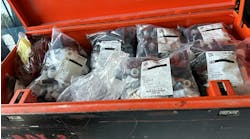Latest from Plumbing
Sponsored
During the past year, various vendors, entrepreneurs and inventors, promoting dual-flush conversion devices for tank-type toilets, have approached numerous water efficiency professionals, water provider organizations, certifying organizations and consumers. Recommending, endorsing or subsidizing such untested products is being questioned.
There are many of these types of products being promoted throughout North America, most of which advertise their ability to convert a 1.6-gal., 3.5-gal., 5-gal. or more fixture from a single-flush, tank-type gravity toilet to a dual-flush toilet. All of these promoters promise water savings by giving the consumer a “choice” between a full flush for solids and a reduced flush, usually approximately one-half the volume of a full flush, for liquids only.
While the goal of reducing water use in the home is admirable, there is no independent evidence that such savings do or will occur as a result of retrofitting the toilet with these devices. No independent field studies of actual real-world installations have been conducted (although one such study is about to commence) and the significant concerns over the efficacy of these types of devices remains. Four primary reasons for these concerns are as follows.
The removal and replacement of an original equipment manufacturer's flush valve with an after-market product changes the full-flush characteristics of the toilet fixture. The delivery of the right amount of water to the bowl at a certain rate is critical to the full removal of all solid and liquid waste from the fixture. This is especially true of 1.6-gal. and 1.28-gal. toilets where the hydraulic characteristics are finely tuned to achieve the maximum force of the water delivered through the flush valve. Changing that profile can adversely affect flush performance, potentially leading to double flushing by the user, thereby increasing water use.
In a perfect scenario, dual-flush retrofit flush valves should be flush performance tested with each model of the gravity-fed toilet into which it is to be installed to assure the purchaser or end-user that flushing performance will not be sacrificed. In reality, however, such extensive testing is largely impractical and, therefore, has not occurred.
Similarly, the reduced flush is particularly vulnerable to unsatisfactory performance from a retrofit product because the user expects a complete exchange of water in the bowl when the fixture is flushed. There is no assurance that the after-market product will, in fact, remove all of the waste. That is, if it appears to the user that the reduced flush has not removed all of the liquid waste and, potentially, toilet paper, the toilet will be flushed a second or third time.
Original equipment manufacturer components internal to the tank not only provide for the efficient evacuation of waste, they also assure that the proper amount of refill water is supplied to the bowl to re-establish a minimum 2-in. (50mm) trap seal, thereby preventing sewer gasses from entering the room. Each model of toilet requires a different volume of refill water to be provided from the fill valve to achieve proper trap seal restoration, adding more water than is required to achieve the trap seal is simply a waste of water. Testing has not been conducted on these dual-flush conversion devices to demonstrate that the appropriate amount of refill water is delivered to the bowl.
Most of the conversion devices are fully adjustable and allow the user to increase the flush volume well above the originally rated volume of the fixture, thereby negating much of the expected savings. Currently, the applicable U.S. national standard that applies to these after-market conversion devices is IAPMO PS 50-2008 — Material and Property Standard for Flush Valves with Dual Flush Device for Water Closets or Water Closet Tank with an Integral Flush Valves with a Dual Flush Device.
This standard imposes certain durability, performance, leakage and marking requirements upon the device, and incorporates, by reference, applicable portions of two additional national standards: ASME A112.19.2, Vitreous China Plumbing Fixtures, and ASME A112.19.5, Trim for Water Closet Bowl, Tanks and Urinals. Most of the conversion devices being promoted have not been tested to the IAPMO standard and, as such, their compliance to the requirements is not assured.
Those installing, recommending or subsidizing these retrofit products should consider these factors also: replacement of the OEM flush valve with an after-market product will likely void any remaining manufacturer warranty on the toilet fixture. In most cases, but not all, installation requires that the homeowner/user turn off the water supply to the toilet, remove all water from the toilet tank, disassemble the tank from the bowl, remove the OEM flush valve, replace it with the after-market product, reassemble the fixture and adjust the new valve to the manufacturer's instructions. Some homeowners may require a plumber or a skilled handyman for this installation.
The purchase, endorsement or subsidy of these after-market devices should be approached with much caution. At this time, we do not recommend the devices for 1.6-gal. or 1.28-gal. toilet fixtures where hydraulic performance is critical.
However, if an individual or agency wishes to proceed, they should insist upon full certification to the IAPMO national standard listed above, require that the product be non-adjustable to water consumption levels above that originally certified (the “rated” flush volume) for the toilet into which the device is to be installed, and insist that the manufacturer provide independently developed third-party evidence that the products as used in a real-world setting actually demonstrate real-water savings.
It is our opinion that the water savings potential and cost-effectiveness of these retrofit devices is doubtful. When a conversion device meets the standard, is independently tested, demonstrates that it will not adversely affect the flush performance of the toilet and delivers the advertised water savings, we will report that information.
Prominent plumbing engineers John Koeller and Bill Gauley are principals of Koeller & Co., Yorba Linda, Calif., 714/777-2744, and Veritec Consulting, Mississauga, Ontario, Canada, 905/696-9391.

